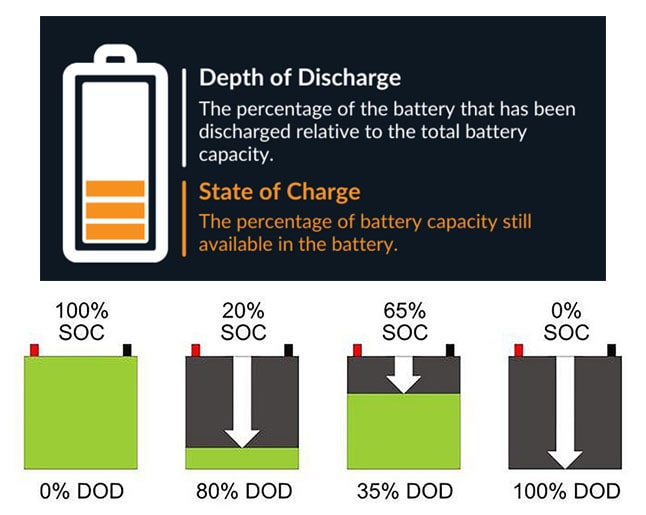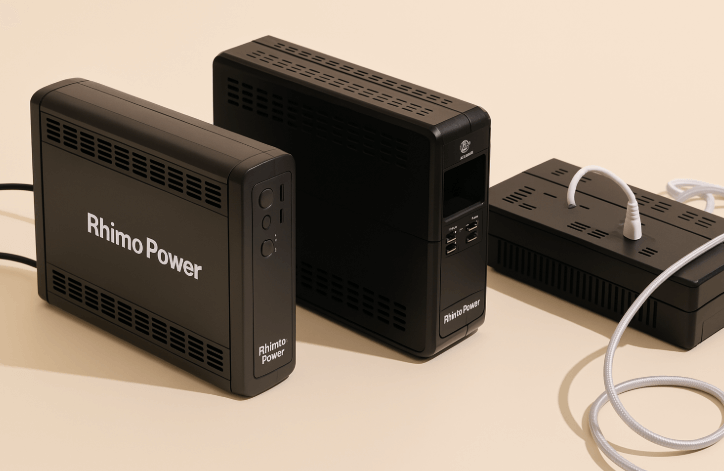Когда речь идет об аккумуляторах, особенно для хранения солнечной энергии, электромобилей или резервного питания,Глубина разряда (DoD) Этот термин встречается часто. Но что именно он означает и почему он так важен для производительности и срока службы аккумулятора?
🔋 Значение глубины разряда
Глубина разряда (DoD) Это процент использованной ёмкости аккумулятора. Например, если используется 40% от общей ёмкости аккумулятора, то DoD будет равен 40%. Оставшиеся 60% — это Состояние заряда (SoC).
Пример:
Если у вас аккумулятор емкостью 100 А·ч и вы потребляете 50 А·ч, глубина разряда составляет 50%.
- 0% DoD = полностью заряжен
- 100% DoD = полностью разряжен
Почему глубокий разряд может быть вреден
Глубокий разряд батареиили регулярное использование батареи на высоком проценте ее емкости (например, 80–100% DoD), может значительно снизить срок службы батареи жизненный цикл. Это особенно актуально для свинцово-кислотных, AGM и гелевых аккумуляторов.
Для каждой батареи существует рекомендуемая максимальная глубина разряда (DoD) для оптимальной производительности. Превышение этого значения может привести к:
- Более быстрое снижение емкости
- Более короткая продолжительность жизни
- Возможный отказ батареи
DoD против жизненного цикла
Существует прямая зависимость между глубиной разряда и количеством циклов, которые может выдержать аккумулятор. Чем глубже разряд, тем меньше циклов вы сможете выдержать.
| Глубина разряда | Расчетный срок службы (свинцово-кислотные) |
|---|---|
| 30% | ~1200 циклов |
| 50% | ~600 циклов |
| 80% | ~300 циклов |
| 100% | ~200 циклов |
Другие факторы, влияющие на срок службы батареи
Помимо DoD, на работоспособность аккумулятора могут влиять и другие факторы:
- Температура: Высокая температура ускоряет химический износ; условия замерзания снижают эффективность зарядки.
- Методы зарядки: Избыточная зарядка или быстрая зарядка без надлежащего контроллера может привести к повреждению.
- Обслуживание: Регулярное техническое обслуживание особенно полезно для свинцово-кислотных и залитых аккумуляторов.
Разные типы батарей, разные допуски
Не все батареи одинаково хорошо переносят глубокие разряды:
- Свинцово-кислотные: Предпочитают плавную езду; высокая глубина разряда значительно сокращает срок службы.
- AGM/Гель: Лучше, чем стандартные свинцово-кислотные, но все равно выходят из строя при глубоких разрядах.
- Литий-ионный: Наиболее устойчивы к глубокому разряду и обладают высоким циклическим ресурсом (часто имеют класс стойкости 80–90% DoD).
Почему Автономные солнечные батареи Имеют высокий уровень разряда и длительный срок службы
В автономных солнечных системах аккумуляторы должны накапливать достаточно энергии для обеспечения дома или участка в ночное время и пасмурные дни. Для этого требуются аккумуляторы, способные безопасно отдавать большую часть своей энергии без быстрого выхода из строя.
Вот почему большинство современных автономных систем используют фосфат лития-железа (LiFePO4) батареи, которые предлагают:
- Высокая глубина поражения: Часто 80–100% без вреда для аккумулятора.
- Длительный срок службы: От 3000 до 6000+ полных циклов.
- Стабильное напряжение: Производительность остается стабильной даже при разрядке аккумулятора.
- Низкие эксплуатационные расходы: Полив и выравнивание не требуются.
Лучшие практики управления Министерством обороны
- Придерживайтесь рекомендуемая производителем глубина поражения.
- Используйте Система управления батареями (BMS) для литиевых систем.
- Установите батареи в прохладное, хорошо проветриваемое помещение.
- Регулярно заряжайте батарею и избегайте разрядов 100%, если только это не предусмотрено конструкцией.
Заключительные мысли
Понимание какова глубина разряда И правильное управление им может значительно продлить срок службы и производительность вашей аккумуляторной системы. Независимо от того, питаете ли вы солнечную установку, автодом или резервное электропитание дома, контроль над Министерством обороны означает более высокую окупаемость ваших инвестиций в электроэнергию.
Ключевые слова: значение глубины разряда, глубокий разряд аккумулятора, что такое глубокий разряд


